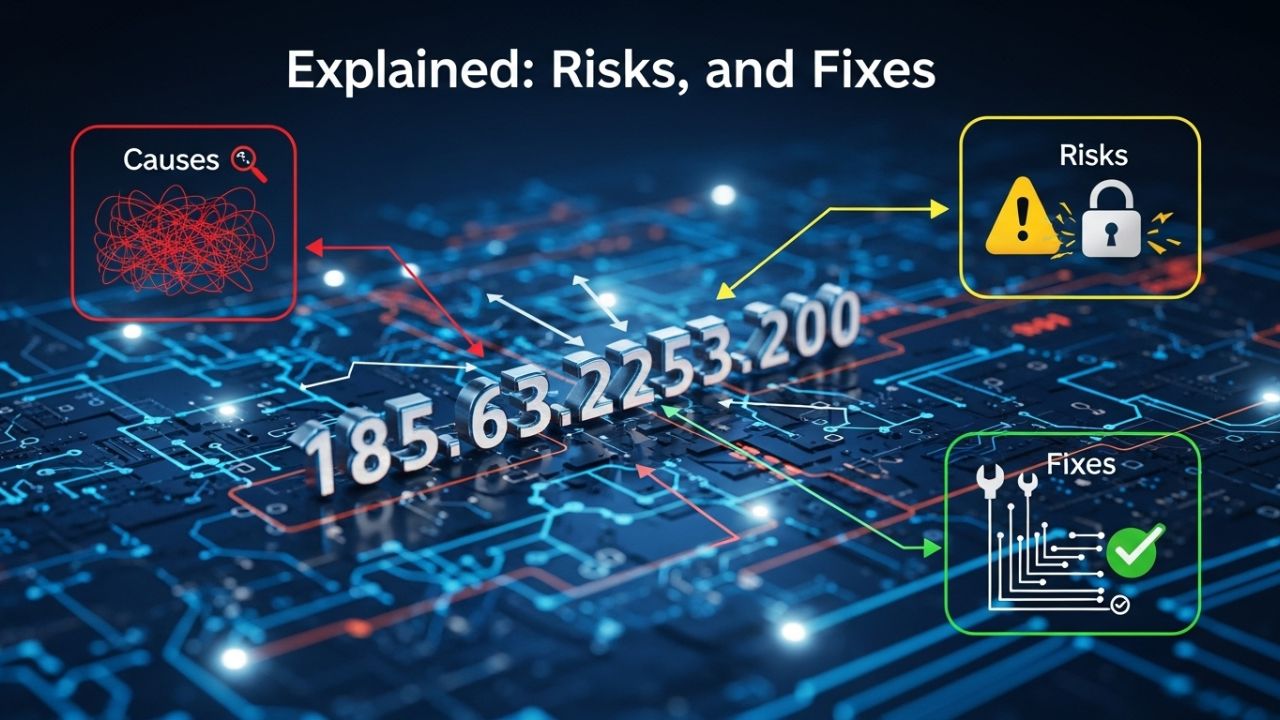185.63.2253.200 Explained: Causes, Risks, and Fixes
In today’s digital era, we often encounter mysterious strings of numbers online that look like IP addresses. One such example that’s recently caught attention is 185.63.2253.200. At first glance, it seems like a regular IPv4 address but a closer look reveals that it doesn’t quite fit the standard format.
In this article, we’ll explore what 185.63.2253.200 means, why it’s important, and what it teaches us about cybersecurity, data tracking, and digital awareness.
What Is 185.63.2253.200?
The string 185.63.2253.200 might appear to be an internet protocol (IP) address. IP addresses are unique identifiers assigned to every device connected to the internet. They’re typically written as four sets of numbers (called octets), separated by dots for example, 192.168.1.1.
However, in the case of 185.63.2253.200, something stands out: the third section, 2253, exceeds the allowed range of 0–255. That means 185.63.2253.200 is not a valid IP address.
So why does it exist? There are a few possible explanations from data entry errors to automated bot activity. Let’s break it down.
Why 185.63.2253.200 Is Not a Real IP Address
To understand this better, it helps to recall how IPv4 works. Each octet in an IP address can only go from 0 to 255. When any part goes beyond that limit, the address becomes invalid.
In 185.63.2253.200, the number “2253” makes it impossible to assign or route through any real network.
Common Reasons Behind Invalid IPs like 185.63.2253.200
-
Typographical or Formatting Errors – Sometimes data gets copied incorrectly from network logs or spreadsheets, creating impossible IPs.
-
System Glitches or Log Bugs – Automated tools that collect IPs from web requests may concatenate digits incorrectly, leading to results like 185.63.2253.200.
-
Placeholder Data – Developers and analysts often use fake IPs during testing or documentation to avoid exposing real addresses.
-
Bot or Spam Artifacts – Some bots and crawlers deliberately use fake IPs to hide their true identity when scraping websites or generating spam traffic.
The Technical Side: IPv4 vs. IPv6 Confusion
There’s also a possibility that 185.63.2253.200 comes from confusion between the IPv4 and IPv6 systems.
IPv6 was introduced to provide a vastly larger pool of unique addresses, written as eight groups of hexadecimal values. Some misformatted IPv6-to-IPv4 conversions or database errors can accidentally produce strange hybrids like 185.63.2253.200.
This shows how transitioning systems or mixed protocols can create false or invalid data in digital networks.
How 185.63.2253.200 Might Appear in Real-World Scenarios
While 185.63.2253.200 itself doesn’t lead to any active host or website, users and analysts might still see it pop up in:
-
Server logs
-
Analytics reports
-
Email headers
-
Firewall alerts
-
SEO or referral traffic sources
When this happens, it usually means one of two things either the data source was corrupted, or someone (or something) intentionally inserted a dummy address to bypass a filter.
Cybersecurity Implications of 185.63.2253.200
Even though 185.63.2253.200 isn’t a valid address, its presence in system records shouldn’t be ignored. Malicious actors sometimes exploit formatting gaps or invalid data to sneak past detection tools.
Potential Security Concerns
-
Phishing or Spam Tracking: Fake IPs like 185.63.2253.200 can appear in fake referral URLs to confuse website administrators.
-
Bot Activity: Automated bots sometimes spoof non-existent IPs to avoid being blocked or blacklisted.
-
Data Pollution: Invalid IPs may distort analytics, leading to incorrect conclusions about visitor sources or geographic locations.
Keeping an eye out for invalid patterns such as 185.63.2253.200 helps improve log hygiene and prevents unnecessary investigation of false data.
What to Do If You See 185.63.2253.200 in Your Logs
If you manage a website, database, or digital network and find 185.63.2253.200 in your analytics, follow these steps:
-
Validate Your Logs: Run an IP validation script to automatically flag impossible addresses.
-
Check for Source Manipulation: See if the fake address is part of a referral link or bot attack pattern.
-
Filter It Out in Analytics Tools: Use regex filters in Google Analytics or Matomo to exclude malformed IPs like 185.63.2253.200.
-
Update Security Rules: Tighten firewall and server rules to block malformed requests.
-
Report Suspicious Activity: If repeated instances of 185.63.2253.200 appear, report them to your hosting provider or cybersecurity team.
Why Awareness Matters
Understanding strange entries like 185.63.2253.200 helps internet users stay alert. While the sequence itself might be harmless, it’s a reminder that data accuracy and validation are vital in an age driven by automation.
For cybersecurity professionals, these anomalies can expose deeper issues perhaps a misconfigured system or a script injection attempt. For everyday users, it’s a glimpse into how complex and imperfect the online world can be.
Broader Lessons from 185.63.2253.200
Beyond its technical oddity, 185.63.2253.200 teaches three key lessons:
-
Always Verify Data Sources: Don’t assume every IP or data point you see is valid.
-
Automate Data Validation: Use software tools that identify malformed inputs early.
-
Stay Informed: Cyber threats often hide behind confusing details knowing what to look for makes all the difference.
The Bottom Line on 185.63.2253.200
To sum it up, 185.63.2253.200 looks like an IP address but isn’t one. The number exceeds IPv4 limits, making it invalid from a networking perspective. Still, its recurring appearance in various logs and online searches shows how even a small typo can spark curiosity and discussion.
In the fast-moving world of data, digital marketing, and cybersecurity, such anomalies remind us that accuracy and awareness matter more than ever. Whether it’s a developer using a dummy address or a bot hiding behind fake data, staying alert to oddities like 185.63.2253.200 is an essential part of maintaining a clean, secure online environment.







